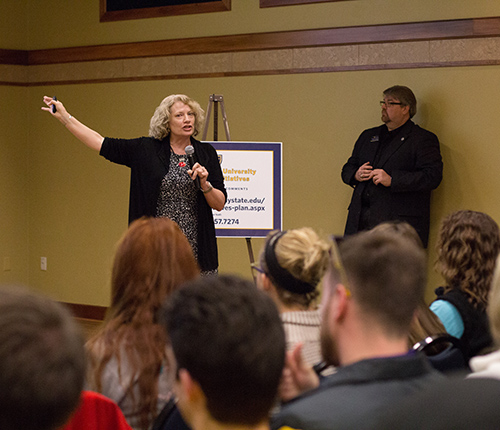
Renae Duncan, associate provost, speaks about the academic excellence committee’s plans at Wednesday night’s meeting.
(WITH VIDEO) – Around 5:30 p.m. Wednesday, the Curris Center Small Ballroom held approximately 80 laughing students.
President Bob Davies joked about holding a microphone, saying he preferred to not stand behind a podium because it made him look small.
Spanning across several rows of chairs were smiling students, but they were not in the Curris Center for comedic purposes. Rather, there were there to hear and ask questions about Murray State’s Strategic Initiatives plan.
Held in a town hall setting, students of all majors, hometowns and involvements were invited to discuss how the University will change over the course of the next seven years.
With a PowerPoint presentation, Davies and committee members reviewed what initiatives students now and in 2022 could expect to see.
Each committee that falls under the overall executive committee – student success, academic excellence, scholarship, research and creative thought and community engagement – discussed their goals and how they plan to achieve them, illustrating in detail what measurable achievements are planned to be reached.
While the town hall highlighted important aspects of the University’s future, the meeting’s intention was to share in planning that future with current students.
“The purpose of tonight is to hear you give us feedback on the next seven or so years on the direction of this University,” said Tim Todd, co-chair of the Strategic Initiatives executive committee.
And feedback there was.
Lauren Cox, freshman from Murray, shared two of her questions with the committee members.
Cox’s questions hit pivital topics for students: the upcoming tobacco ban and having Winslow Dining Hall swipes utilized in the Thoroughbred Room.
In response, Davies stressed that there was a separate committee for the tobacco ban, but that elements of student health existed in the student success committee. Additionally, Cox’s question on Winslow swipes emphasized the purpose for the town hall meeting, which was to engage in discussion regarding changes students would like to see.
Cox said she attended the meeting to ask questions and to be involved. Since both her parents work for the University, she wanted to be able to give back, too, she said.
While she went into the meeting with an open mind on the committees and discussion points, she said she appreciated the ability to voice her concerns when she had them.
“I really like that we are able to give our own feedback,” Cox said. “You could email that address, and it’s open to everyone. The president’s here and University staff members are here – you can tell how much they care about the University.”
Faculty, staff and students were in attendance Wednesday, but in some instances, there have been little to no student attendance at previous town hall meetings.
Ryan Knight, one of two students on the student success committee, said students and the University depend upon each other, with the students acting as the core component.
He said in past meetings for his specific committee, there have been no students in attendance.
Knight said students should begin to learn and to get involved in the planning process because they will begin to see changes on campus due to the Strategic Initiatives plan.
“A lot of the faculty and staff are a part of (the plan) because they can see the changes as they come through,” Knight said. “The students are going to see some of these changes over the next several years as they graduate and maintain a relationship with the University or as they come in. That cycle will continue for the next seven years.”
The cause, to Knight, for the previous lack of student involvement in the plan is simply due to not knowing about it.
He said there have been multiple offices on campus that have reached out to students about different town hall meetings in the past through RoundaboutU and email. However he said gathering the attention of students lies in social media.
“What we discussed in the student success committee was getting the message out through Facebook,” Knight said. “Obviously, that had great success. Through that we directly contacted students who served as an intergal part of this process.”
Story by Mary Bradley, Editor-in-Chief



























































































